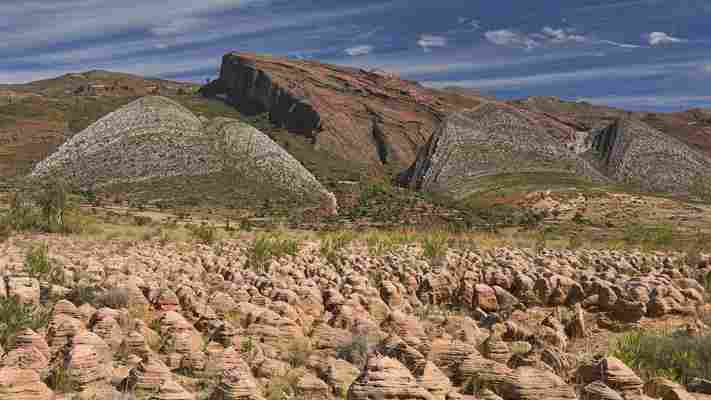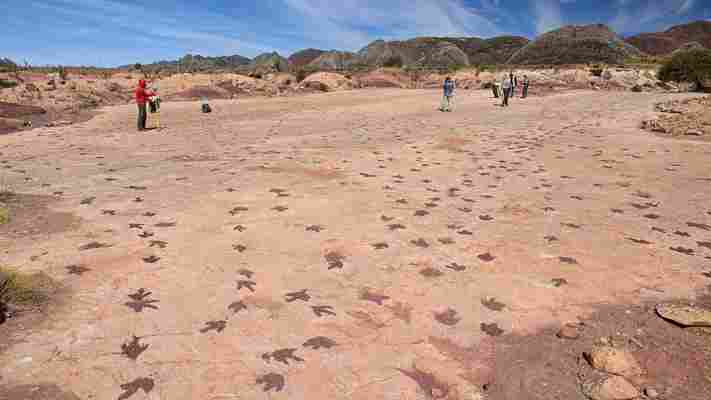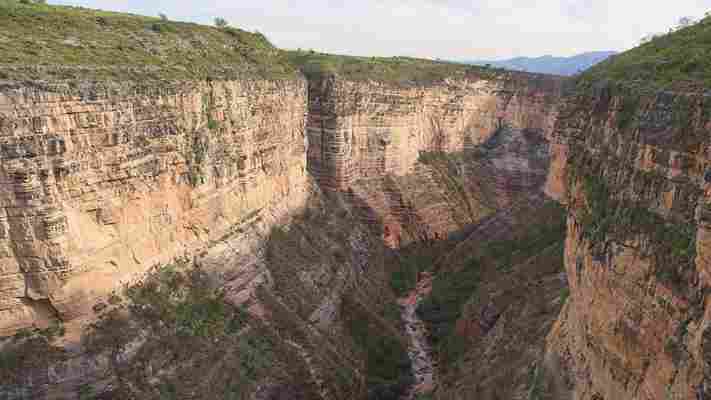Land of the dinosaurs in Bolivia’s ‘Jurassic Park’


Torotoro, Bolivia, is surrounded by colourful and bizarre karst landscapes
It’s well worth the bumpy and dusty five-hour drive from Cochabamba city along winding mountain roads to reach the sleepy Bolivian hamlet of Torotoro. Set in a long valley in the Eastern Cordillera of the Andes mountains at 2,600m, the town is surrounded by colourful and bizarre karst landscapes and rock formations. This surreal scenery is the result of wind and glacial erosion and the fact that this entire area was at one point in time underwater as part of the Andean Cretaceous Sea. (Credit: Dave Stamboulis)

Intrepid tourists can explore the natural wonders in surrounding Torotoro National Park
Intrepid tourists are starting to head here to explore the natural wonders in surrounding Torotoro National Park, which includes the impressive Torotoro Canyon, more than 250m deep and home to nesting condors, monk parakeets and red-fronted macaws, as well as emerald pools and orange-amber cliffs. Hiking into the depths of the canyon has become one of the park’s biggest draws. (Credit: Dave Stamboulis)
More than 3,500 dinosaur footprints have been discovered at Torotoro
However, there is an even more important reason why Torotoro is becoming a bucket-list destination – and why it may become a household name in the coming years. More than 3,500 dinosaur footprints have been discovered here, starting in 1968, with many more lying hidden in the earth. When South America and Africa drifted apart during the Cretaceous Period, this former sea became a wetland and wildlife corridor ripe for grazing. As the area was soft and muddy, the dinosaur prints became embedded in the mud, later solidifying into stone following periods of drought. Sauropods, theropods and ankylosaurs from the Cretaceous Period (which began at the end of Jurassic Period 145 million years ago and ended at the start of the Paleogene Period 66 million years ago), and both biped and quadruped dinosaur prints and fossils, have been uncovered at Torotoro, making this an extremely exciting dinosaur-related site. (Credit: Dave Stamboulis)
The tracks found at Torotoro are believed to be around 80-140 million years old
The footprints, called "huellas" in Spanish, may not be obvious to the first-time observer looking at the marks in the cracked and indented earth, which is why the local guides and researchers fill them in with dirt to make them more distinct. The tracks found throughout the valley range from 20-50cm in size and are believed to be around 80-140 million years old. Our guide, a local Quechua woman, showed us the difference between them, such as carnivores having pointed toes and herbivores featuring rounded ones. (Credit: Dave Stamboulis)
Raúl Esperante (pictured) has been studying Torotoro's fossils and footprints
Raúl Esperante (pictured), a Spanish palaeontologist who works for the Geoscience Research Institute in California, has been studying these fossils and footprints, spending entire days in the strong sun cleaning surfaces and marking freshly discovered tracks with his team. While there are many stray individual tracks to discover throughout the park, Esperante's team has marked out an entire new area of the valley over the last two years, with hundreds of prints that allow you to truly grasp the site's scope and significance. His expertise in pointing out dinosaur tail drag marks, claw marks and pad prints helps to bring the ancient giants just about back to life; you can almost envision an armoured ankylosaurus or long-necked sauropod stomping through the area. (Credit: Dave Stamboulis)
The town of Torotoro is incredibly proud of its Jurassic status
Meanwhile, the town of Torotoro is incredibly proud of what’s in its backyard, and its quiet cobblestone streets and public areas are filled with dinosaur memorabilia and odes to their prehistoric showpieces, erected by the village to show off its Jurassic status. Dominating the sleepy central plaza next to the main church are a variety of dinosaur statues; when I walked through at dusk, it felt so eerie that I half expected a real-life pterodactyl to fly out of nowhere. (Credit: Dave Stamboulis)
Torotoro buildings feature large dinosaur heads or bodies
Hotel fronts and even the city hall building feature large dinosaur heads or bodies hanging from their balconies, while restaurants and craft beer bars have sprung up with names like El Dinosaurio or Cafe Cretacico. Meanwhile, the local government has invested funds in an ambitious project that will eventually pave the road in from Cochabamba, cutting travel time in half and hopefully turning the expected crowds into a cash cow. (Credit: Dave Stamboulis)
Travellers can take guided tours through Torotoro's incredible surrounding landscapes
In the meantime, travellers can take guided tours through the incredible surrounding landscapes. Besides the dinosaur-stomped areas, these include a series of deep caves with rivers running through them, or the popular El Vergel waterfall, set at the bottom of the Torotoro Canyon, where turquoise pools make for perfect swimming holes after descending a series of 800 stone steps to the canyon’s base. (Credit: Dave Stamboulis)
Torotoro may soon prove to be on every Latin America travel bucket list
For those who love adventure travel and the film Jurassic Park, Torotoro may soon prove to be on every Latin America travel bucket list, as the outdoor possibilities here are endless, from canyoning, climbing and abseiling to spelunking, trekking and, of course, checking out the remains of our prehistoric pals. (Credit: Dave Stamboulis)

